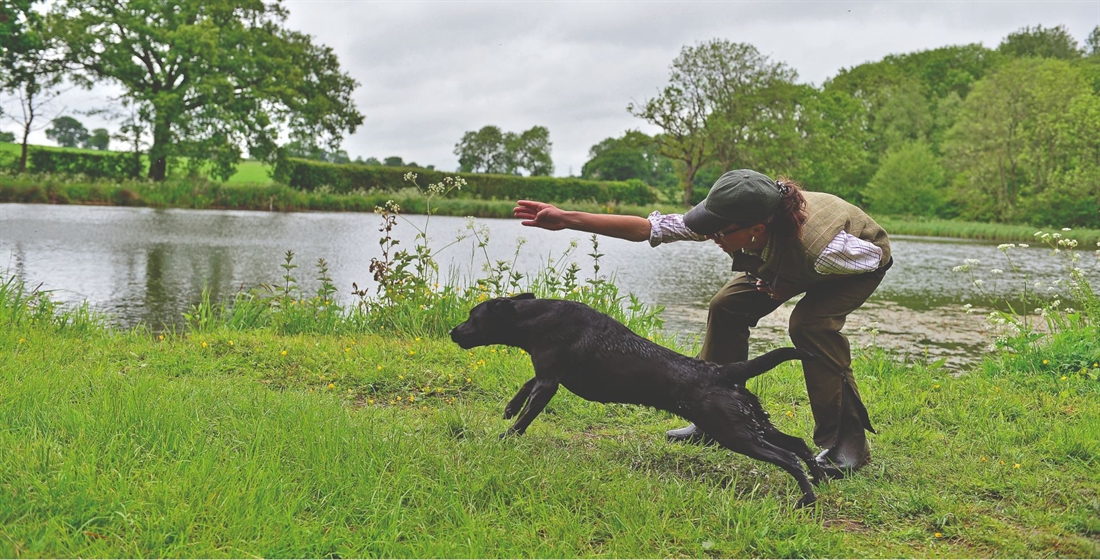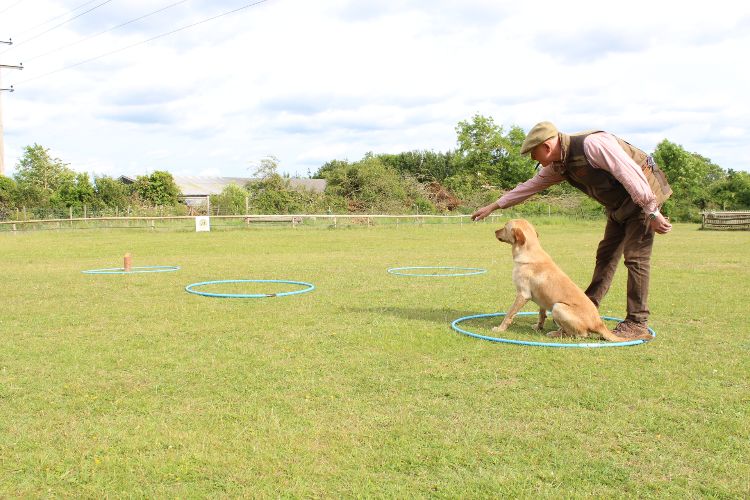Gundog training: blind retrieves
One of our gundog training goals is to successfully send the dog for birds or dummies they have no prior knowledge of. Here’s Howard Kirby’s guide on how to perfect the ‘one-cast’ blind retrieve.

Over the past few months in the magazine, we have taken a look at building a communication system, and language, that enables us to be able to communicate with, and direct our dogs onto a dummy or shot game. While this language is primarily considered to be linked to retrieving, for those of us that use dogs to hunt or produce game for the Gun, there are some commands that are common to both.
What is a blind retrieve?
The term blind retrieve is generally used to describe one that the dog has no prior knowledge of. The handler needs as accurate a description as possible for the location of the bird.
Regular readers may remember the article in which we discussed how important it is for gundog handlers to be able to accurately estimate distance. This is primarily so they are able to interpret distances given to them but also to be able to offer information to fellow handlers and of course the dog. With humans, vocal and pointing gestures will be given BEFOREHAND. A dog, however, might be given directional commands and instruction DURING the retrieve.
This leads nicely into my first piece of advice. All of the preparatory work and training that we’ve been doing up to this point has been to prepare for this retrieve. Alignment, straight lines, stop whistle and directional commands are, by now, all well and truly being understood.
One cast retrieving
All of the highly skilled control and directional commands pale into insignificance when compared to a dog that is ‘sent away’ from its handler. It then takes and holds its line before arriving in the area, whereupon it drops onto scent and uses its nose to hunt for and retrieve the bird… in one cast. This is my favourite saying when working with retrieving dogs. You might wish to use this phrase and mindset when training your dog.
Whenever you and your dog pull off a ‘one-cast’ blind retrieve it should give you a real buzz. When working as a shotgun coach we abide by the rule of ‘gun up, shut up’ – the theory being, that all instruction is given to the client prior to mounting the gun. Once the gun is in the shoulder, one needs to allow the pupil to concentrate and get on with the job. This is a concept you might consider from the moment you cast your dog. Try applying the ‘cast off, leave off’ rule. The fewer commands we offer, the easier it will be for the dog to get on with its work.
This is the point when the “what if”s always get asked. “What if the dog needs me to stop and direct it on to the bird?” Well yes you may be right, but you’ve missed my argument for the ‘one cast’, principle. Please understand that I’m not trying to be clever, patronising or controversial. It’s likely that the reason we need to intervene is because the dog has not taken the line we asked it to take. Therefore, we might need to consider some more work on schooling the dog in its line taking.
I have taken considerable time here to discuss the mindset and importance of ‘one cast’ before we head into blind retrieves. The reason for this is because the better trained the gundog is, the less input will be required to complete any given task. Therefore it makes sense to train your dog to the highest standard you can. This will get the dog to the hunting area as quickly and efficiently as possible.
On shoot days, working tests and field trials you will be marked down for every extra command you offer your dog. More importantly, if you are not careful, these commands might distract or inhibit the dog’s ability to get on with its job.
 Pre-retrieve checklist!
Pre-retrieve checklist!
Let’s get back onto the subject of the blind retrieve. I’m going to draw up a little checklist of the things we might consider before sending our dogs to make a blind retrieve.
- Ensure you are absolutely clear about the location of the bird.
- Do a risk assessment for your dog’s safety, such as fences, ditches, water, roads, railways.
- Is this retrieve within your dog’s ‘pay grade’? Don’t set them up to fail.
- Consider the wind direction and how it will influence your dog. Are you going to use the
- wind to help? Try and cast the dog just downwind of the bird.
- Alignment. Are you and your dog in agreement? Does the dog understand where you want them
- to go?
- If there is other shot game on the way to your retrieve, consider how it might influence the dog.
- Look at the topography of the ground – humps, bumps, gulleys, tramlines and tracks. Think about how they might take your dog off line or how you might use these to your advantage.
The blind retrieve cast
Having completed a quick but thorough ‘pre-cast’ check, ensure your whistle is in your mouth. We can now send the dog. The vocal command is your choice. “Back” is mine. Booooom! I love this part of a retrieve, the dog launches like a super-charged rocket. I understand that some of you are probably thinking, Kirby’s way too emotionally involved with this s**t. You’re not wrong! As an aside, last night I was watching a documentary about the biological functions of human pleasure. This gundog stuff really gets my happy hormones going. I know that some of you will understand!
Here’s another checklist of things to consider once you’ve sent your dog:
- Keep a close eye on how things are unfolding. Be ready to react. If you know your dog well, you can make split second decisions. With some, you’ll need to interact and give direction immediately. Others are best left alone, they’ll put themselves right.
- If the dog starts to deviate off line in the training field, you might stop him and bring him back before re-casting. Perhaps allow the dog to fail, then bring it back before trying again. Remember, in a test or a trial, you can’t bring them back and have another go. You’ll have to deal with what you’ve got.
- If you stop the dog, don’t rush your commands. Ensure the dog is looking and actively listening before you direct him. If not, hold him until he does.
- The dog’s body language, head movements and direction will give you clues as to whether or not it intends to listen to you or already has its own agenda. Often if the dog has stopped but is indicating that it has got a whiff of scent, do you go with the dog’s nose? Or insist that it listens to you and follows instructions? Any decision you make will be reliant on how certain you are about the location of the bird.
- Are you going to insist the dog holds the area?
- Maybe the bird has moved or has run.
- If the bird has run, you’ll really need to trust your dog and let them figure it out.
- Having encouraged you to leave the dog alone, there are times when swift intervention will be appropriate. Perhaps to keep the dog in the area.
If now we factor in that different breed groups will behave very differently when sent out on a retrieve (for example, a retriever will behave very differently to an HPR), then, as always, my brief attempt to offer advice can lead to provoking more questions than it answers.
Training a dog to reliably make blind retrieves requires time, patience and some well thought through training. Know your breed and try to be realistic about your dog and its strengths and weaknesses. I hope that you find some of my thoughts and observations helpful. As always have fun and Keeeep Training!




 Pre-retrieve checklist!
Pre-retrieve checklist!
